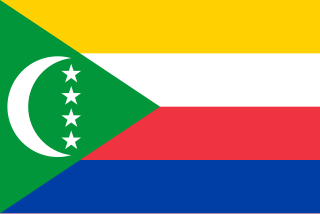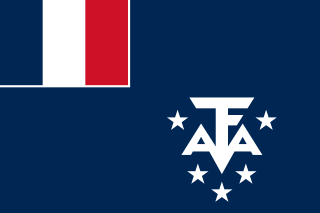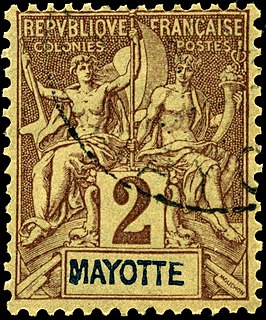
The Comoros, officially the Union of the Comoros, is an island country in the Indian Ocean, at the northern end of the Mozambique Channel off the eastern coast of Africa. It shares maritime borders with Madagascar and Mayotte to the southeast, Tanzania to the northwest, Mozambique to the west, and the Seychelles to the northeast. Its capital and largest city is Moroni. The religion of the majority of the population, and the official state religion, is Sunni Islam. As a member of the Arab League, it is the only country in the Arab world which is entirely in the Southern Hemisphere. It is also a member state of the African Union, the Organisation internationale de la Francophonie, the Organisation of Islamic Cooperation, and the Indian Ocean Commission. The country has three official languages: Comorian, French and Arabic.

Mayotte is an overseas department/region and single territorial collectivity of France officially named the Department of Mayotte. It consists of a main island, Grande-Terre, a smaller island, Petite-Terre, and several islets around these two. Mayotte is part of the Comoros archipelago, located in the northern Mozambique Channel in the Indian Ocean off the coast of Southeast Africa, between northwestern Madagascar and northeastern Mozambique. The department status of Mayotte is recent and the region remains, by a significant margin, the poorest in France. Mayotte is nevertheless much more prosperous than the other countries of the Mozambique Channel, making it a major destination for illegal immigration.

Mayotte is an island of volcanic origin in the northernmost Mozambique Channel, about one-half of the way from northern Madagascar to northern Mozambique. Mayotte is part of the Comoro Islands, and like them is the result of a former hot spot, the oldest of the Comoros archipelago, formed about 7.7 mya. Mayotte has an area of 374 square kilometres, and a coastline of length 185.2 km. Its maritime claims are an exclusive economic zone of 200 nautical miles, and a territorial sea of 12 nm.

The Comoro Islands or Comoros form an archipelago of volcanic islands situated off the southeastern coast of Africa, to the east of Mozambique and northwest of Madagascar. The islands are politically divided between the Union of the Comoros and two territories of France: the department of Mayotte and the uninhabited Glorioso Islands, a part of the Scattered Islands in the Indian Ocean, the 5th district of the French Southern and Antarctic Lands.

The Scattered Islands in the Indian Ocean consist of four small coral islands, an atoll, and a reef in the Indian Ocean, and have constituted the 5th district of the French Southern and Antarctic Lands (TAAF), though sovereignty over some or all of the Islands is contested by Madagascar, Mauritius, and the Comoros. None of the islands has ever had a permanent population.

Joseph Marie Henry Alfred Perrier de la Bâthie was a French botanist who specialized in the plants of Madagascar.
Maore Comorian, or Shimaore, is one of the two indigenous languages spoken in the French-ruled Comorian islands of Mayotte; Shimaore being a dialect of the Comorian language, while ShiBushi is an unrelated Malayo-Polynesian language originally from Madagascar. Historically, Shimaore- and ShiBushi-speaking villages on Mayotte have been clearly identified, but Shimaore tends to be the de facto indigenous lingua franca in everyday life, because of the larger Shimaore-speaking population. Only Shimaore is represented on the local television news program by RFO. The 2002 census references 80,140 speakers of Shimaore in Mayotte itself, to which one would have to add people living outside the island, mostly in metropolitan France. There are also 20,000 speakers of Comorian in Madagascar, of which 3,000 are Shimaore speakers.

Foetidia is a genus of flowering plants first described as a genus in 1788. Most authors place the genus in the family Lecythidaceae, the sole genus in the subfamily Foetidioideae, but some prefer to treat it as a distinct family, the Foetidiaceae. It is native to eastern Africa and to various islands in the Indian Ocean.

Mamoudzou is the capital of the French overseas region and department of Mayotte, in the Indian Ocean. Mamoudzou is the most populated commune (municipality) of Mayotte. It is located on Grande-Terre, the main island of Mayotte.
Amyrea is a plant genus of the family Euphorbiaceae first described as a genus in 1941. It is native to Madagascar and to nearby Mayotte Island in the Indian Ocean.

Dracaena reflexa is a tree native to Mozambique, Madagascar, Mauritius, and other nearby islands of the Indian Ocean. It is widely grown as an ornamental plant and houseplant, valued for its richly coloured, evergreen leaves, and thick, irregular stems.

The Mayotte national football team represents the French overseas department and region of Mayotte in international football.
The association football tournament at the Indian Ocean Island Games which is organised every 4 years for the Islands in the Indian Ocean.
The postage stamps and postal history of the Comoro Islands is an overview of the postage stamps and postal history of the Comoro Islands, an Indian Ocean archipelago located on the south-east side of Africa.

This is an overview of the postage stamps and postal history of the Indian Ocean island of Mayotte, one of the Comoros Archipelago islands located on the south-east side of Africa.
Kibosy is a dialect of Malagasy spoken in the French-ruled Comorian island of Mayotte. Malagasy dialects most closely related to Bushi are spoken in northwestern Madagascar in the area of Antsiranana (Diego-Suarez) and Mahajanga (Majunga), which is also the closest point in Madagascar to Mayotte. Kibosy and Majunga together are considered one of the Malagasy languages by Glottolog.

Mayotte – overseas department of France located in the Comoros Archipelago in the Indian Ocean. The department comprises the main island of Grande-Terre, a smaller island, Petite-Terre, and several islets at the northern end of the Mozambique Channel, between northern Madagascar and northern Mozambique. The territory is geographically part of the Comoro Islands, but has been politically separate since the 1970s. The territory is also known as Mahoré, the native name of its main island, especially by advocates of its inclusion in the Union of Comoros.
The islands of Africa are a major geographical sub-region of Africa, and represent a distinct demographic and historical cultural sphere of influence on the continent.
Léon Joseph Henry Humblot was a French naturalist and botanical collector.
Labramia is a genus of plants in the family Sapotaceae described as a genus in 1844. De Candolle initially named the genus Delastrea, which is a homonym for an older fungus name by Tulasne, so De Candolle changed the name to Labramia in the appendix to the same book.










